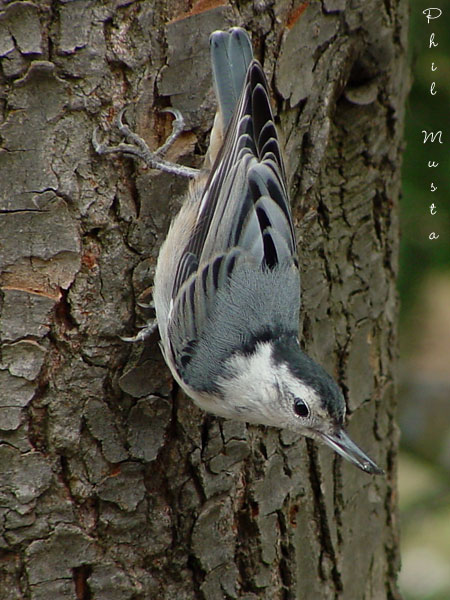(id) |
(→External Links: Amended video link) |
||
| Line 47: | Line 47: | ||
{{GSearch|Sitta+carolinensis}} | {{GSearch|Sitta+carolinensis}} | ||
<br /> | <br /> | ||
| − | {{Video| | + | {{Video|White_breasted_Nuthatch}} |
[[Category:Birds]] [[Category:Sitta]][[Category:Videos]] | [[Category:Birds]] [[Category:Sitta]][[Category:Videos]] | ||
Revision as of 13:32, 14 July 2016
- Sitta carolinensis
Identification
Length 13-15 cm
- Blue-grey above
- White underparts and face
- Black crown
Variation
Three forms should be distinguishable in the field: slender-billed (Pacific), Rocky Mountain, and Carolina (Eastern half of the continent). See post 58 in this Birdforum thread[4].
Distribution
Largely resident from British Columbia, Ontario, and Nova Scotia south to southern California, Arizona, Gulf Coast, and central Florida. Absent from most of Great Plains.
Taxonomy
Subspecies[1]
Nine subspecies are recognized:
- S. c. carolinensis - North-eastern North America to Dakotas, Kansas, Oklahoma and eastern Texas
- S. c. nelsoni - Rocky Mountains of western US to northern Mexico (Sonora and northern Chihuahua)
- S. c. oberholseri - South-western Texas (Chisos Mountains) to eastern Mexico (northern Sierra Madre Oriental)
- S. c. mexicana - Mountains of western Mexico (Sierra Madre Occidental)
- S. c. kinneari - Mountains of western Mexico (Guerrero and Oaxaca)
- S. c. tenuissima -British Columbia and Cascades to Sierra Nevada of northern California
- S. c. aculeata -Western Washington to Oregon, California and northern Baja (Sierra Juárez)
- S. c. alexandrae -Mountains of northern Baja California (San Pedro Mártir)
- S. c. lagunae Mountains of southern Baja California (Sierra de la Laguna)
Three additional subspecies, atkinsi, umbrosa and cookei[2], are not recognised by all authorities.
A recent paper proposes that the White-breasted Nuthatch should be split into 4 species corresponding to the areas The Pacific, The East, ESNNR [Eastern Sierra Nevada and Northern Rockies] and RGM [Rocky Mountain, Great Basin and Mexico][4].
Habitat
Deciduous and mixed forests, also coniferous.
Behaviour
Usually seen creeping on tree trunks, head downward
Breeding
Five to six white eggs, lightly speckled with red-brown, are laid in a cup of twigs and grass lined with feathers and hair. The nest site is in a natural cavity, bird box, or hole excavated by the birds.
Diet
They have a varied diet of insects, seeds, acorns and nuts and are known to stores food behind loose bark for use during the winter. Commonly seen at bird feeders.
Vocalisation
Call: A nasal yank-yank.
Song: A series of low whistled notes.
References
- Clements, JF. 2008. The Clements Checklist of Birds of the World. 6th ed., with updates to December 2008. Ithaca: Cornell Univ. Press. ISBN 978-0801445019.
- eNature
- Wikipedia
- Birdforum thread (especially from post29) discussing taxonomy of this species
Recommended Citation
- BirdForum Opus contributors. (2024) White-breasted Nuthatch. In: BirdForum, the forum for wild birds and birding. Retrieved 19 April 2024 from https://www.birdforum.net/opus/White-breasted_Nuthatch
External Links




